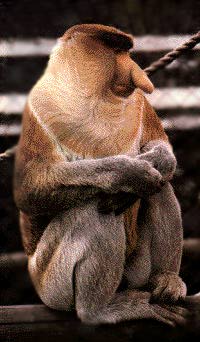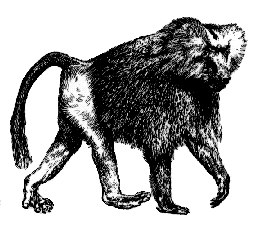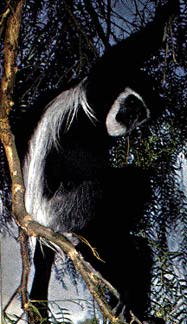
 |
Old World Monkeys |
Old World Monkeys live in Africa and Asia. They are found in many different climates, from tropical forests, to deserts, to ice covered lands in Japan. They are all quadrupedal, arboreal and terrestrial. Two fat pads, covered with hard skin are found on either side of the tail. The pads are called ischial callosities, and are thought to make sitting on rocks and branches more comfortable. The nostrils are narrow and point downwards. They have tails, but they do not have prehensile capabilities.
 Baboons
occupy a wide variety of ecological zones in Africa and Asia. They are
omnivorous, with a diet consisting of fruit, grass, roots, insects, and
meat. A very large upper canine is present in the males. The muzzle shaped
snout is not related to smell, but to the space needed for the canine root.
Baboons
occupy a wide variety of ecological zones in Africa and Asia. They are
omnivorous, with a diet consisting of fruit, grass, roots, insects, and
meat. A very large upper canine is present in the males. The muzzle shaped
snout is not related to smell, but to the space needed for the canine root.
Baboons spend roughly 30% of their time in trees. The rest of the time is spent on the ground. In the evenings, they all return to trees or rock cliffs to sleep.
Baboons live in large troops that
can be as large as 200 individuals. The average size for a troop is closer
to 40-80 individuals. There are more females in a group than males. There
is a dominance heirarchy between both the males and the females. The highest
ranking male of the group is dominiant over all other males and females.
He usually will have one or two other males, ranking second and third,
who help him maintain order. Adolescent males leave their natal group and
find another one to join. The  females
stay with the group that their mother belongs to. There is a ranking system
between the females that is estab- lished at birth. A daughter assumes
the rank just below her mother. The ranking of the females is stable, where
as with the males it frequently changes. The dominant male is challenged
by other males who want to be in the highest ranking position. These challenges
often lead to fights and injuries.
females
stay with the group that their mother belongs to. There is a ranking system
between the females that is estab- lished at birth. A daughter assumes
the rank just below her mother. The ranking of the females is stable, where
as with the males it frequently changes. The dominant male is challenged
by other males who want to be in the highest ranking position. These challenges
often lead to fights and injuries.
Baboon behavioral studies have
shown that friendships are an important aspect of male, female, and infant
relationships. ![]()
For more information, consult the reading "What are Friends For?" Baboon friendships are based on other things than sexual access.
 Colobus
Colobus
The Colobus monkey lives in tropical and montane forests in Africa. They are what are called foliovores. As a result of their leaf diet their stomachs have become enlarged. The special shape and size of their stomach allows them to eat the large quantity of leaves required for nutrition, and improves their ability to digest the leaves.
Colobus Monkeys are quandrapedal, and have been observed climbing and walking along the top of branches. Occasionally, they may hang under a branch by their arm. Their long tails are used for balance.
They live in groups of15 individuals.
However, this number can vary. Males are dominant over females, but there
is not a strict ranking system.